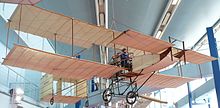Voisin-Farman I.
| Voisin-Farman I. | |
|---|---|

|
|
| Type: | Biplane - pusher propeller - airplane |
| Design country: | |
| Manufacturer: |
Aéroplanes G. Voisin with Farman developments |
| First flight: |
1907 |
| Commissioning: |
1907 |
The Voisin-Farman I is a biplane in canard that the then-known motorist Henri Farman of the brothers Voisin based on their Voisin Standard leave had build.
construction


The Voisin Standard was largely based on the model of the Wright Flyer . As with this one, the engine was installed behind the pilot, but acted directly on only one pressure screw. The tailplane was attached to two outriggers at the very front, while the two rudders at the rear sat in a kind of box, which was formed by two slightly curved, but immobile, supporting surfaces arranged one above the other. The chassis had two steerable and sprung large spoked wheels at the front and two small ones under the rear box. An Antoinette V8 engine served as the drive.
Henri Farman continuously modified the Voisin biplane based on his experience in flight operations and thus achieved an increasingly powerful aircraft. For example, the stabilization surfaces between the wings have been removed. At times, Farman tried out an enlarged vertical stabilizer. In October 1908 he replaced the wing twisting used up to then with ailerons .
use
On October 26, 1907 , Farman achieved the absolute world speed record for land planes with 52.7 km / h on the airfield in Issy-les-Moulineaux .
On January 13, 1908, he also carried out the world's first officially monitored powered flight over a closed one-kilometer route on the airfield in Issy-les-Moulineaux. With that he won the Grand Prix d'Aviation , donated by Archdeacon and Deutsch, which was endowed with 50,000 francs. Later the distance could be increased up to 24.125 km.
Farman's flight on October 30, 1908 over 27 kilometers in 20 minutes from Chalons to Reims was reported by Scientific American as the first European overland flight (see picture).
The Voisin brothers exhibited the aircraft in December 1908 at the Aero Salon in Paris.
Whereabouts
It was later converted into a three-decker and sold in 1909 to the Vienna Syndicate for the organization of sightseeing flights . There it was rebuilt into a two-decker. Flight attempts with this modified machine were repeatedly unsuccessful. Finally the plane came to the Army History Museum .
Technical data (1907)
- Length: 11.40 m
- Span: 10.00 m
- Wing area: 49 m²
- Takeoff weight: 544 kg
- Engine: Levasseur Antoinette V 8 with 50 hp
literature
- Leonard E. Opdycke: French Airplanes before the Great War, Schiffer Publishing Ltd., ISBN 0-7643-0752-5
Individual evidence
- ↑ Picture with the Antoinette V8 engine in the Farman machine
- ↑ Flight of January 2, 1909, p. 8


